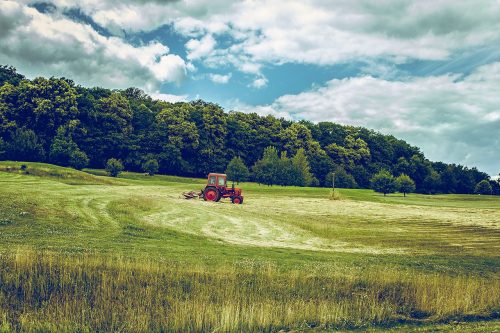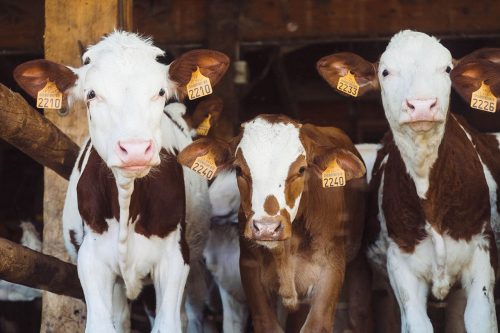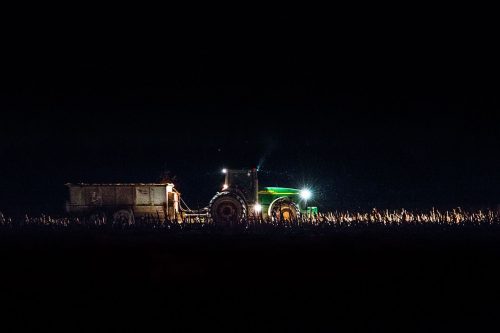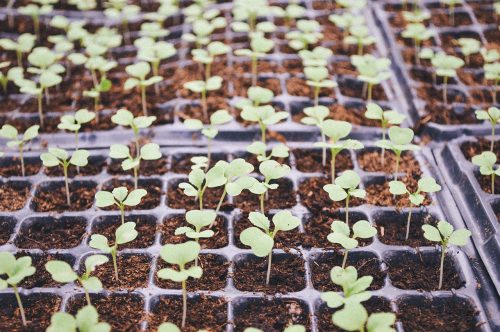Is the Future of Agriculture in Robotics?

Every single day we are reminded that the robot revolution is moving forward. From autonomous vehicles to automated cashier, the robots are taking a larger and larger place in our daily lives. And while our attention has been focused on robots in manufacturing industries, there's one vital field of activity they might disrupt even more than anything else. Indeed, to quote the authors of one of the most renowned papers on the topic:
"[...]food is a necessity that must be produced at all costs. We therefore need either more farmers or more ways to produce food with limited manpower. The robots are coming to the rescue."Are you ready for the robo-agriculture?
The Agricultural Robotics Market Is About to Blow Up
Today, it's the 2nd biggest market for professional robotics and estimated to be worth $2.75 billion. According to many researchers, the agricultural robots market should have an annual growth rate of over 20% until 2022. Eventually, it will reach a market capitalization of $13 billion. This spectacular growth will be fueled by the democratization of automated machines, by their ever-decreasing costs, but mostly by the diversification of the nature of the machines. Today, a vast majority of robotics on farms are for milking cows or indoor machines. But in the very near future, robots will start working outdoors. You may have already seen some automated tractors or drones but, truth be told, these are still sparse initiatives. That being said, the day when we'll see robots roaming through farms is closer than you can imagine. For instance, we already have advanced prototypes for feeder robots, surveyance, and weeding. A future à la Interstellar with fully automated farms might just be around the corner. According to a MarketsandMarkets Research report, the most important applications will be in:- Harvesting Management
- Field Mapping
- Dairy Farm Management
- Soil Management
- Irrigation Management
- Pruning Management
- Weather Tracking and Forecasting
- Inventory Management
Modern Farming is Broken and Inefficient
Starting from the premise quoted earlier, the robot-enhanced agriculture is also a question of survival. Today's farming is far from optimal on so many levels. According to an FAO report, family-run farms produce over 75% of the world's food. And about 75% of all farms in the world are smaller than one hectare. And those small farms are way more efficient than the large ones. Contrary to the rule of thumb that large-scale productions see a decrease of inputs per unit of production, farming is actually more efficient and productive at smaller scales. Bringing robots and technology into the equation will improve all farms' productivity. If we want to tackle the challenges of feeding the ever-increasing world's population, we'll need to make sure that the food production process minimizes the inputs needed and maximizes the yields. That's something only robots can help us achieve. The future of farming is technology and data-driven. Let's take for example the modern irrigation. What do you think will be most productive? Using hundreds of meters of aerial pipes like we can see today in linear or central pivot irrigation...Or arrays of moisture sensors spread across the field, making sure the soil has the perfect moisture levels at the perfect places for crops to grow as productive as possible (without mentioning the use of weather forecasts to adapt the irrigation schedule to ensure as little water is used as possible)? Which brings us to our first point.Agricultural Robots Will Be So Much More Efficient
The first obvious improvement brought by farming robots will be that they'll be autonomous. While people will be able to focus their mind on more interesting tasks, they will be roaming the properties, relentlessly accomplishing their mission. Whether it'll be surveyance, removing weeds and pest, caring for crops,... you can be sure that you won't have to be behind them to get the job done. Thanks to online databases and forecasts, combined with the data provided by external and internal sensors, they will have a complete understanding of the situation, far beyond what any human could. This will allow them to make informed decisions, and obtain the optimal outcome. Furthermore, as all of these robots will be powered on batteries and electric motors, they will also have a positive impact on the energy consumption and carbon footprint of the farms. Some of them might even be perfectly independent thanks to solar panels on them. They'll be an important part of a greener future for mass-scale farming. Besides, this will also allow for a quieter exploitation. Thus it will also reduce the noise pollution generated by agriculture. In a nutshell, by bringing artificial intelligence and around-the-clock activity, the robots will help optimize the yield of the farms far beyond what could humanly be possible. Maximizing the production while minimizing the costs in energy, water, time,... Can you imagine greenhouses with automatic lighting and watering designed to get the best crops for the minimal energy? Or tractors relentlessly roaming the fields with drones surveying cattle day and night and rovers on a permanent weed-control duty? Or watering hectares and hectares of lands using only the optimal amount of water for each square meter? This is what tomorrow will be made of.Robots on Farms Will Improve Human Lives
Farm employment is far from a riskless job. It often exposes workers to pesticides, long working hours in the heat and sun, and poor sanitary conditions among other direct health risks. There are many serious health hazards affecting farmworkers. For instance, the Organic Dust Toxic Syndrome, caused by grain and silage dust, is a common illness among farmers. Less known, the exposure to excessive noise produced by machines can permanently damage workers' hearing. Furthermore, most of the work is physical and outside. Thus increasing the risk of accidents caused by fatigue, difficult environment and weather, and aging tools. However, only some of these risks are being covered by employment and health insurances. Some are not even covered by national legislation and regulations. By bringing robots to do these tasks, we will be reducing the risks on the human workers. Which will not only have a positive impact on their lives, but also on the people around them, and the society at large. And obviously, as mentioned above, the more efficient the farming, the better we all are. Maximizing yield while reducing the environmental and societal costs can help us tackle the challenges of a growing population and the lack of efficiency of modern intensive farming. We can all agree that a healthier planet would be a very strong improvement in everybody's lives!There Are Many Questions Raised by the Farming Robots...
... And they might impact their democratization more than you could suspect. As with any technological revolution, many questions need to be answered. Today, the focus of governing entities is on the legislation and regulation of the potential agricultural robots. Due to the fact that these robots will be in an open environment and will probably be massive pieces of machinery. While it's for obvious security reasons (you don't want a pilotless combine to go on a road trip), it can create serious entry barriers to startup trying to break into this field.
Indeed, the certification process can already decide of the fate of a prototype. For instance, the Centéol developed by AgreenCulture is a promising autonomous robot weighing 300kg. However, until it gets its certification of conformity with the European Union norms, it can't be officially released on the market. This is just one of many examples of speedbumps that the farming robots will have to overcome to become mainstream.
Governments Are Jumping on the Bandwagon for Agricultural Robotics
Seen all that legal blur and balancing it against the numerous advantages, some governments are starting to realize the possible impact and the need for action. Whether it's the positive fallback of leading the way on that matter or the risk of missing the train on that new revolution. For instance, France, one of the largest agricultural production in the world, through its national agronomic and research agency IRSTEA, has announced in November 2017 the creation of an accelerator program "RobAgri". Its goal couldn't be any clearer: "Intensify the conception, validation, and dissemination of tomorrow's robots". One of the biggest government programs on that topic in the world, RobAgri gathers almost 50 public and private stakeholders in order to impulse a dynamic collective to conceive robotic systems fitting the needs of farmers and markets. Besides its workgroup, RobAgri is partnering with Naio Technologies to organize a yearly convention about agricultural robotics. The Forum International de la Robotique Agricole (FIRA) will hold its 3rd edition on December 13th and 14th in Toulouse, France. Likewise, back in 2014, the UK set out an "agri-tech" strategy with over £150M in public funding to develop and commercialize agricultural technologies.You Too Can Have Your Own Agricultural Robot
The robotic farming isn't reserved to only big exploitations. If you wanna be part of the agricultural revolution brought by robotics, we can only suggest you get yourself a FarmBot. This open-source project allows you to build your own automated veggie garden. Powered by a Raspberry Pi and an Arduino board, it offers to bring a CNC head to your raised bed. Thanks to its open-source software you can access your crop from anywhere and make sure everything's running alright. Thanks to its link with OpenFarm.cc and weather data, FarmBot can optimize the care of your crops. According to its manufacturer, it can save you up to $1,500 a year for your vegetable consumption. Or if you're looking for a smaller-scale project, there's the MoAgriS project over at Hackaday that will be a great start.
If you're looking to automate your garden's irrigation and watering systems, then look no further than the GreenIQ Smart Garden Hub available at RobotShop.com. Using data from weather services or from moisture sensors (3 are included with the base product), this hub can save you up to 50% of your water consumption. You can use its additional master channels for a water pump and a fertilizer tank. It can also take control of your lighting based on sunset and sunrise schedules. And obviously, you can control it from your computer or your smartphone from anywhere in the world. Or ask Alexa to do it for you!
Or if you're looking to bid farewell to the mowing chore, then you should take a look at our catalog of robotic lawn mowers. Like the robotic vacuum cleaners you might already have inside your house, these robots will relentlessly roam across your lawn to make sure it's always looking perfect. These are also about to become a common thing as their market is projected to reach values of around $3 billion by 2023 with a CAGR over 15% for the next five years.
Needless to say, whether you're part of it or not, the agricultural robotic revolution is well underway.
Thanks for helping to keep our community civil!
Notify staff privately
You flagged this as spam. Undo flag.Flag Post
It's Spam
This post is an advertisement, or vandalism. It is not useful or relevant to the current topic.
This post is an advertisement, or vandalism. It is not useful or relevant to the current topic.
You flagged this as spam. Undo flag.Flag Post








